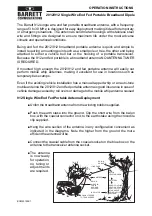
Site preparation
3-14
Chapter 3: Installation
98-146706-A
and S band. If the d min. separation listed below is applied, antenna damage is normally
avoided.
“d min.” is defined as the shortest distance between the radar antenna (in any position) and
the surface of the SAILOR 900 Ka ADU.
The separation distance for C-band (4-8 GHz) radars should generally be the same as for SX-
band radars.
Radar interference
Even at distances greater than “d min.” in the previous section the radar might still be able
to degrade the performance of the SAILOR 900 Ka system. The presence of one or more S
or X-band radars within a radius up to 100 m may cause a minor degradation of the Ka-
band connection. The degradation will be most significant at high radar pulse repetition
rates. As long as receiving conditions are favourable, this limited degradation is not
important. However, if receiving conditions are poor – e.g. due to objects blocking the
signal path, heavy rainfall or icing, low satellite elevation and violent ship movements – the
small extra degradation due to the radar(s) could cause poor connection quality.
The presence of S-band radar(s) is unlikely to cause any performance degradation – as long
as the minimum distances (d min.) listed in the previous section are applied.
It is strongly recommended that interference-free operation is verified experimentally
before the installation is finalized. If radar interference is suspected, or the antenna is
X-band (~ 3 cm / 10 GHz) damage distance
Radar
power
SAILOR 900 Ka ADU
d min. at 15° vertical separation d min. at 60° vertical separation
0 – 10 kW
1.0 m
1.0 m
30 kW
2.0 m
1.0 m
50 kW
3.3 m
1.7 m
Table 3-5: Minimum radar separation, X-band
S-band (~ 10 cm / 3 GHz) damage distance
Radar
power
SAILOR 900 Ka ADU
d min. at 15° vertical separation d min. at 60° vertical separation
0 – 10 kW
2.0 m
1.0 m
30 kW
3.0 m
1.5 m
50 kW
5.0 m
2.5 m
Table 3-6: Minimum radar separation, S-band
SAILOR900Ka-IM-98-146706.book Page 14 Thursday, July 16, 2015 11:07 AM
















































